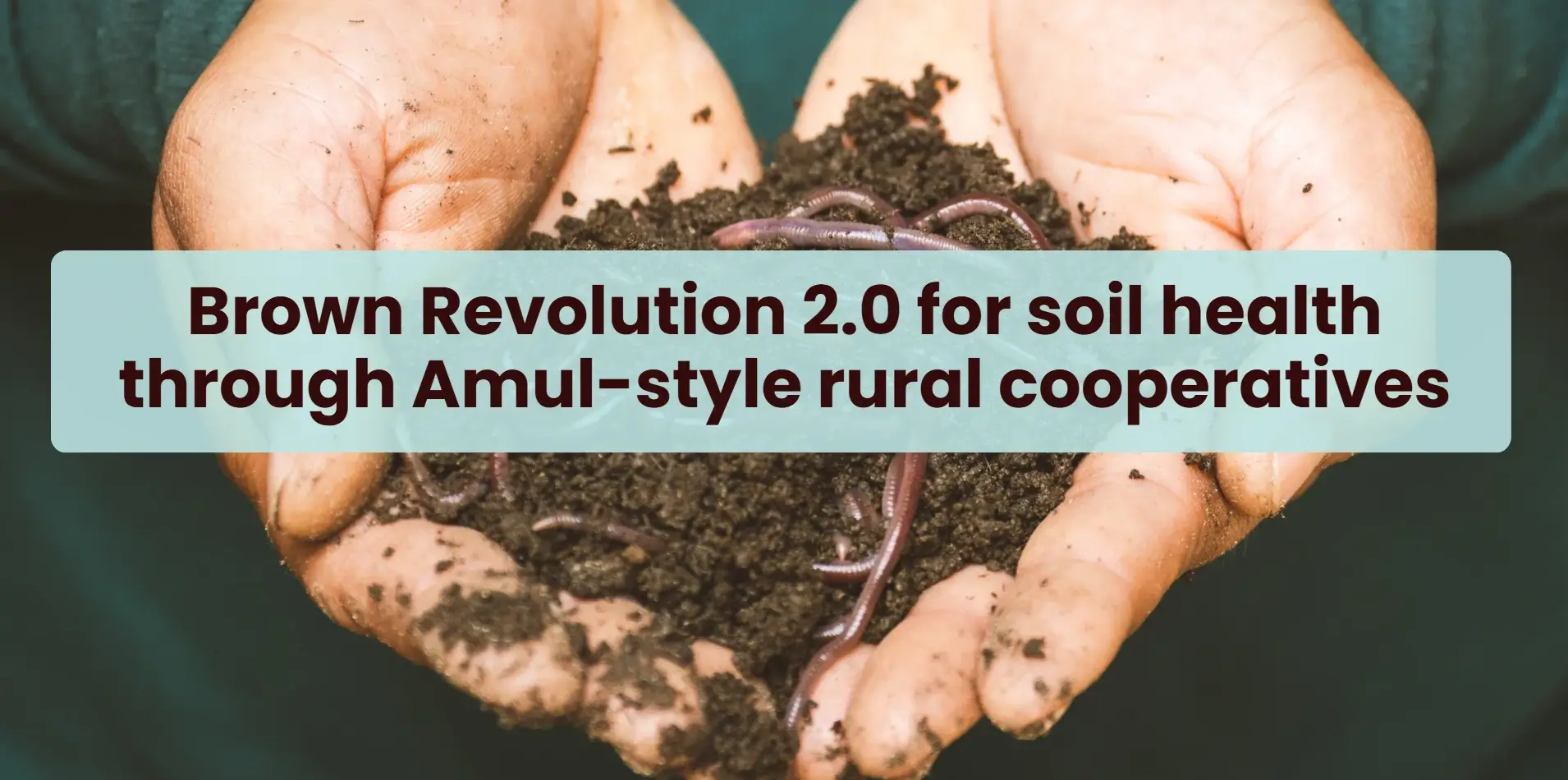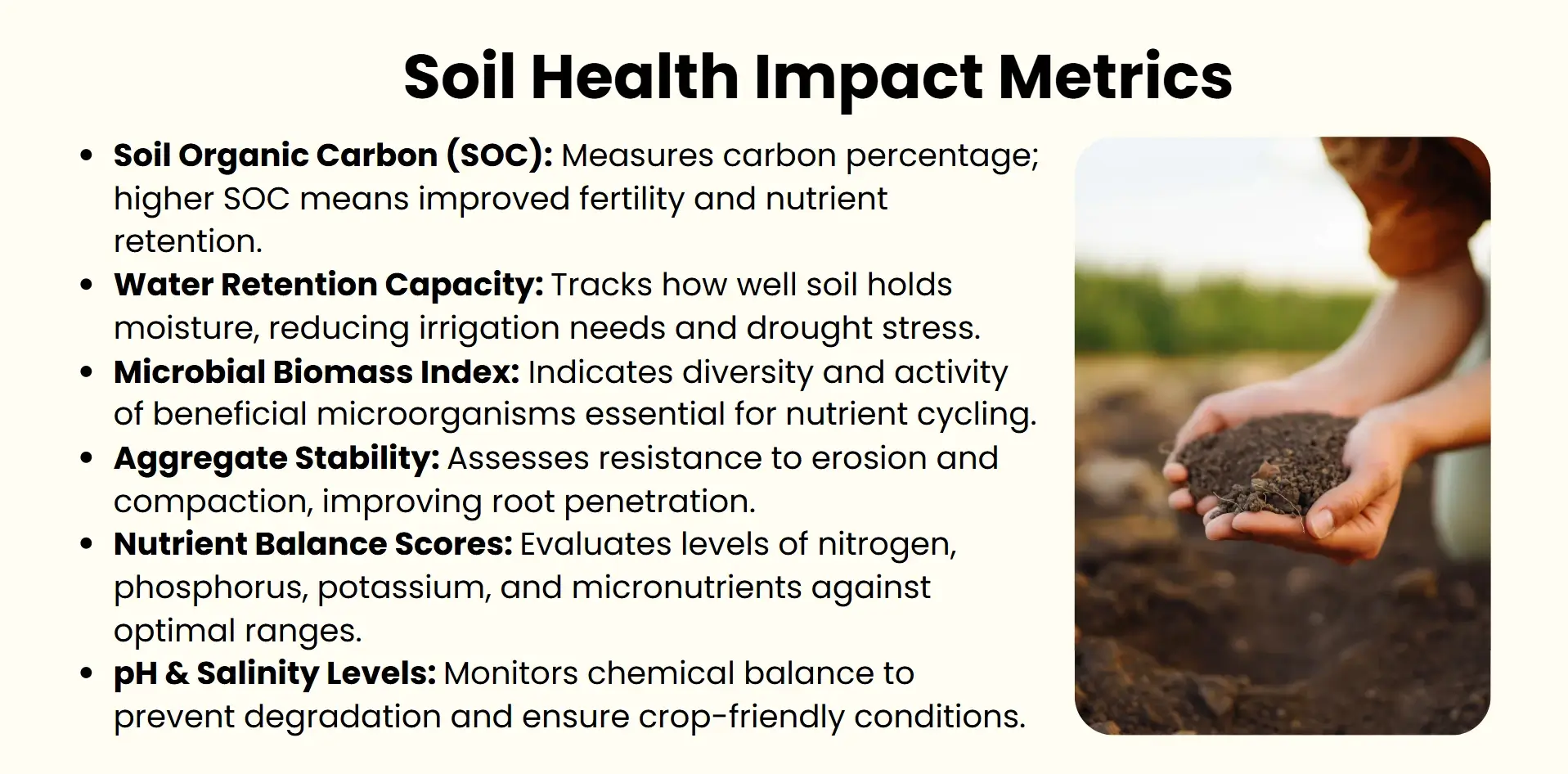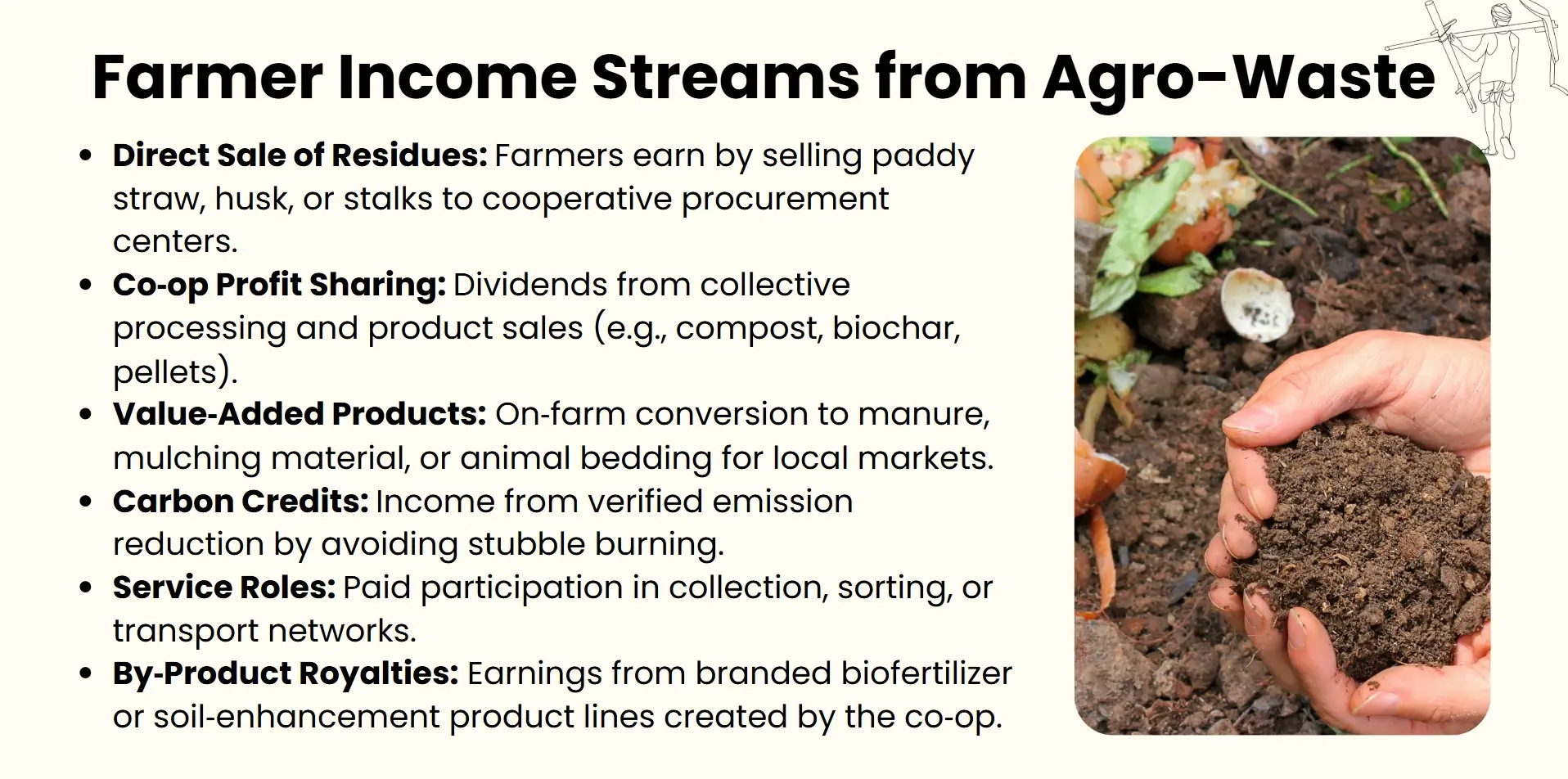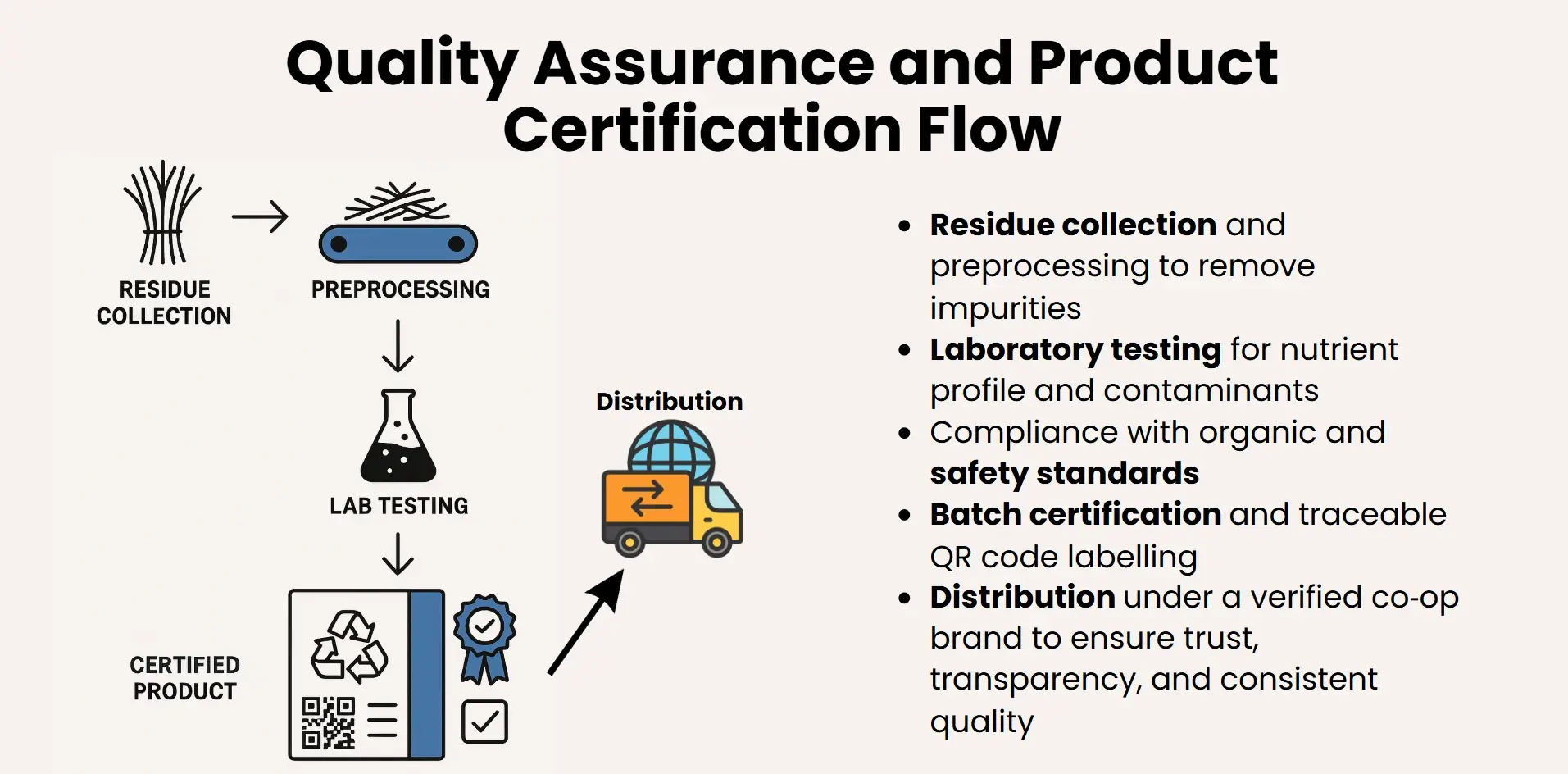This article suggests a country-wide, Amul-type cooperative framework to convert crop residue and other agricultural waste to certify organic inputs to soil that can increase farmer earnings, soil quality and environmental safety.

A more serious issue is the issue of degrading fertility, which is being encountered by India and its agricultural heartlands, besides the burning or unutilised production of millions of tonnes of agro-residues every year. The soil health is being stripped away due to the overuse of chemical fertilizers and organic matter, which impacts long-term productivity, climatechange resilience, and the livelihoods of farmers. Meanwhile, unused crop residues are a huge potential that could revive the soils, reduce air pollution, and provide income in rural communities. The notion of a Brown Revolution 2.0 is a variant of this opportunity to a grassroots network of farmers across the country that decentralises the potential of agricultural waste, leading to the creation of certified organic soil inputs like compost, biochar and bio-fertilizer products. With the famous example of Amul in the dairy industry using a cooperative model, it is based on local ownership, transparent chains, and the morality of products, offering not only trust but viability of the market. With the help of technology, training and money through empowering rural cooperatives, India can start with the goal of closing the loop between crop harvest and soil renewal and go well beyond waste to turn waste into wealth. Besides reinforcing food security, the approach is in line with sustainable developmentgoals, and besides, it can provide a trajectory of soil commons restoration in the country with millions of smallholder farmers lifted out of poverty.
Lessons from the Amul
The milk was not Amul genius; it is the architecture that transformed volumes of tiny, spotty milk products into an affable, value-loaded brand. The cooperative model with its three-tier structure, which is the Anand pattern of village societies, district unions, and state federations, can be replicated on biomass. At the village scale of the biomass society, they collect residue, impose simple standards of quality and transparent payments based on quality. The pre-processing and conversion processes, composting, vermicomposting, and production of biochar, bio-gas digester support a district resource hub, with testing by labs of moisture, C:N ratio, maturity, contaminants. State federations differentiate, certify batches, develop brand equity, negotiate bulk sales, and they make sure that farmers get margins above raw residue.
By changing the dairy logic, it is possible to exchange the cold chain of milk with moisture balancing and contamination prevention. Rather than fat/SNF tests, moisture, ash and foreign matter grades with digital weighment and immediate payment are used to support confidence. The skepticism is overcome and translated into repeat demand through a widespread brand of soil inputs that is promoted by cooperative ownership and third party certification. With extension services, this generic awareness is substituted by evidence- demo plots, optimal levels of application of products by crop and soil, seasonal bundles that fit within the sowing window. This is important because the service hub, logistic,pre-processing, and retail nodes can be owned by women welfare groups and the youth in their own service enterprise thus making it a village-based and win-win circular economy with that feel-good sense of authorship.
Decentralized Rural Cooperatives
The decentralized rural cooperative is a radically different course that can solve the Indian agricultural and ecological threats that are piling up.
- They establish a value-retention ecosystem; ensuring that the ownership and decision making lies in the hands of local farmer collectives, who are less likely to have any value extracted by intermediaries.
- The role of such cooperatives in the case of agro-waste management will be village level collection, aggregation and primary processing of residues thus transport cost is low and post-harvest losses will reduce.
- Nearby location also allows timely management, higher moisture levels, and implies impurity prevention, which is important in regard to upcoming high-quality compost and biochar and biofertilizers production.
- In addition to being efficient, this model promotes inclusive growth. It creates job opportunities in terms of collection, processing, quality control, and marketing, particularly in case of self-help groups of women and small ventures of youth organizations in rural areas.
- The decentralization also facilitates the product diversification that is aligned to the local soils, crops, and markets to promote the adoption rates among the farmers.
- The cooperative design creates a framework of accountability, transparency and trust which is helped by quality-based pricing and plow-back of surpluses into local assets.
- To the environment, it alleviates stubble burning, increases soil organic matter, and climate resilience at the grass-root.
- Economically it converts waste to a regular source of income to smallholders.
Value chain roadmap: Residue to reliable soil inputs
A clean, precise, village-first value chain can convert India agro-residue to a sourced trusted soil input. It is a blueprint that accelerates alignment of field to bag incentives, quality, and logistics, adding credibility and livelihoods at the local level.
Procurement and pre-processing
A village-season specific residue map may be used to direct targeted off-take of panchayats, FPOs, and custom-hiring centres. Pricing incentives based on quality (moisture, ash and foreign matter slabs) and weighing/pay-out on-spot using digital scales get rewards based on clean and prompt supply. The segregation training, tarpaulin-lined bays, and simple equipment i.e., balers, choppers, moisture meters minimize contamination, and the transportation of bulk. Pickups are scheduled so as to match harvest and thus reduce storage losses and tendency to burn. Uniformity of the feedstock will be achieved in the village nodes which shred and adjust moisture content before being consigned to the district hubs.

Product mix and processing technologies
It is in-vessel or aerated windrow composting that provides reliable maturity schedules; co-composting with manure restores C:N ratio and increases nutrient concentration. The high-end product vermicompost is fed with fully mature, screened compost. Clean pyrolysis is used to make biochar as long-term carbon and as a carrier in hybrid blends of char-compost. Community biogas plants up-value wetter feedstocks and stabilized digestate brings nutrients back to farmland. Microbial biofertilizers and bio stimulants (e.g., PSB, KMB, Trichoderma), complete the portfolio and are chosen depending on local soils and crops.
Quality certification and assurance
Certain specifications, moisture, C:N, pH, EC, maturity (respiration test), pathogens, and heavy metals build trust. Rapid assays are done at district labs; 3rd third-party audit is done periodically to check compliance. The QR-based traceability to source lots is indicated on each batch, test values, suggested application rates by crop/soil, and storage directions are also labelled. Accepted standards of dirty feedstock safeguard brands. Transparent dashboards and harmonized standards allow farmers, retailers and institutional buyers to see evidence of quality.
Branding, distribution, and extension
Cooperative identity is associated with associative verification through a farmer‑owned Soil Health brand. Varied demand is satisfied with multi‑channel distribution, through agri‑dealers,farmers’ producer organizations, and producer associations of crop farmers, panchayat stores, and e-commerce, with anchor buyers in municipalities, plantations, and other public works. The adoption loop is closed by extension: demo plots through KVKs, season-wise advisories, and bundling partnerships between products of soil tests and applicators. Purchasing of used bags and a discount on loyalty reaffirms repetition.
Virtual backbone and performance feedback
Lightweight platform records lot‑wise chain designation, quality grades and immediate payment. Sensors monitor temperature and aeration of the compost; under or over-processing is avoided by alerts of abnormalities. Analytics helps in predicting the flow of the feedstocks, routes and matches the production according to demand. Data on KPIs that impact key performance indicator measures such as soil organic carbon, defect rates, and farmer revenue derived through residues are posted publicly on dashboards. Pay-for-performance finance and carbon accounting enhance cash cycles and reward the verified outcomes.

Governance and Financial Architecture
The effective Brown Revolution 2.0, however, cannot do without a governance system as transparent, cooperative and scalable as Amul is.
- The bottom tiers are the village biomass societies that are farmer owned and involved in aggregation of residues, regulation of quality standards, and timely, quality based payments to members.
- Such societies contribute to district resourceunions that are able to process, test quality and organize logistics. State soil health federations above them coordinate certification, branding, inter-district supply-demand balancing and marketing on a large scale.
- The decision-making process is bi-directional, i.e. members take part in the decision-making process over the operations, whereas federations will execute the technical supervision and market knowledge.
- The model is a combination of seed funding by the government and the cooperative raising of capital. There is a gap in funding at early stages of viability and concessional credit provided by bodies such as NABARD to build out processing units, labs, storage, and digital systems.
- Expansion and innovation resources can be supplemented through green bonds, CSR partnerships, and climate finance. The sources of revenue will be the sale of compost, blends of biochar, biofertilizers, service contracts of residue management, along with possible carbon credits in case of verified reduction in emissions.
- Excesses get reinvested in the areas of capacity and product expansion and societal well-being, making a virtuous circle of development and credibility. It is a farmer-centric architecture that ensures financial sustainability and quality assurance is the anchor of long-term resilience.
Implementation roadmap
The practical road to Brown Revolution 2.0 begins modestly, with rapid learning and scaling that which is resilient: technically, financially, and socially.
Phase 1: Pilots (years 1-2)
Identify 5-7 high-residue districts having a good presence of panchayats and markets that are close to them. Erect stand-up village biomass societies to feed a small number of district hubs with the object of experimenting with logistics, mixes of technologies, and incentive structures. To have a foundation to make impact claims later, determine baselines of soils, air quality and farmer economics.
- Site selection: How intense, the level of institutional preparedness, diversity of crops and nearness to buyers.
- Technology portfolio: Technology comparison of side-by-side trials between aerated composting, char-compost mixes, biogas with digestate stabilization and biofertilizers.
- Incentives design: Quality-based pricing, digital real-time payments and seasonal bundling of services (collection + inputs).
- Evidence indicators: Adherence to quality specifications, unit cost on a per-tonne-processed basis, farmer net contribution on residues, net movement of SOC in the earth.
Phase 2: Scale-up (years 3-5)
Make SOPs standardized based on the experiences of pilots; open training academies to the operators, lab technicians and co-op managers. Diversify the network to all agro-climatic regions, and develop demand with demos, retailer roping and institutional buyers. Combine concessional credit with working-capital lines and performance-linked grants.
- Network expansion: reproduce the village societies and centres, communal services to be maintained, and QA.
- Market building:Tie-ups with Agri-dealers, PACS, and state procurement of landscaping/forestry.
- Operational excellence: Route optimization, preventive maintenance, and batch‑wise traceability.
- Capital stack: Concessional loans, guarantees, green bonds and early carbon revenue where methodologies are applicable.
Phase 3: Consolidation (years 6-10)
Increase resilience and profitability. Portfolios should be localized to soils/crops, precision application advisory embedded, and buffer climatic and market shocks created. Enhance inter-governance and auditing practices.
- Soil programs: Multi-year programs with connections between soil tests, application rates and target yields.
- Risk management: Contingency stocks, insurance and diversified material inputs.
- Governance: Periodical social audit, member dividends and open surpluses allocation.

Threats and countermeasures
- Quality variance: implementing SOPs, batchism and price differentiation; commitment to operator training and crude controls (moisture meters, sieving) to cut variance at origin.
- Contamination quality and safety: Pre-screen residues at aggregation point, source segregation must be required, use of reject procedures and periodic heavy-metal/pathogen audits with corrective action plans.
- Feedstock logistics and seasonality: Residue maps and forward contracts; village-level pre-processing and covered storage, routes, and plant fixed to be multi-feedstock.
- Market acceptance and belief: Running demonstration plots and agronomic advice, provide a guarantee of performance and small pack trials, package the soil tests with the inputs and allow credit during pay after harvest.
- Financial sustainability and liquidity: Safe working-capital facilities and guarantees, stage capex, revenue diversification (compost, biochar mixes, and services) and a reserve fund under maintenance.
- Capability and governance gaps: Matching professional managers and cooperative oversight, training schools and credentials, tax incentives to quality and periodic social audits.
- Policy and regulatory uncertainty: Aligning with national, state standards, sign multi‑year MoUs, keep compliance dashboards, and create an industry consortium to initiate dialogue with state regulators on permits and movement.
- Competing end-uses of biomass: Using local-level cascading use strategies, zoning to adjust between energy and fodder and soil demands and give precedence to soil returns in areas where shortages are most pronounced.
Conclusion
The Brown Revolution 2.0 lies in the re-engineering of what is now an environmental liability, namely agricultural residue, to become a source of re-greening the environment, rural livelihoods, and climate security. Through a system of cooperatives, as Amul has demonstrated, India can tap the untapped potential of the villages as value creation is created at the source of the resources. The model is a closed-loop system that links quality assurance, farmer ownership, and market trust, which enriches soils and sustains livelihoods. Other than supporting the economy and the environmental aspects, it also creates a sense of community and a commitment to the general community in supporting the agricultural roots of the country. Phased, evidence-based scaling, effective governance, and policy consistency will be the key to success. The time has come to bring a change, and through a concerted effort Brown Revolution 2.0 could be more than just a policy suggestion, but it could develop into a farmerdriven mass movement that will not only make the soils of India more productive, but revitalize the farmers by affirming their livelihoods, and it will provide food security to the country over the centuries to come.